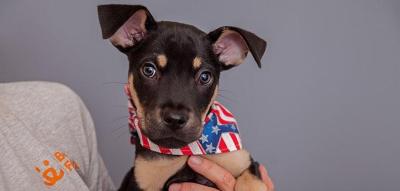
How to Keep Pets Calm During Fireworks
For many people, the Fourth of July means fun and relaxation — enjoying a day off and watching fireworks. But for some dogs, cats, and other pets, fireworks can be stressful and anything but enjoyable. A pet’s reaction can range from mild (wanting to snuggle or hide until the thunderous noise stops) to severe (breaking through barriers to run away or being really destructive). The good news is there are ways to help pets who are scared of fireworks.
How to keep pets safe during fireworks
When fireworks start, some pets immediately seek out a dark hiding place. If that is your pet’s coping mechanism, help them find a dark, windowless place — e.g., a closet or a crate covered in a blanket — to wait out the noise.
You can try comforting your pet, but if they ignore your attention, go ahead and leave them alone. Some pets prefer to simply hunker down for the duration, and we need to respect that choice. Check on your pet periodically, though, to make sure they're OK.
Home starts with you
If your pet decides they want to be with you, here are a few suggestions to help ease their discomfort and anxiety:
- Close the windows and curtains of the room you are in to help muffle the sound.
- Add some background noise that is slightly louder than the usual volume you might use. Avoid the urge to turn the background noise up to full volume, though, because that might add to your pet’s stress.
- Run a fan. The sound and vibration of a fan can help cover up the bothersome fireworks sounds.
- Give your pet a durable chew item. For some pets, chewing on something provides an outlet for their anxiety.
- Cover your pet with a blanket to give comfort and help them feel safer.
There are also several products that can help pets remain calm:
- ThunderShirt: This product fits like a snug T-shirt and uses gentle pressure to calm dogs and cats. You’ll want to teach your pet to wear the ThunderShirt during a non-stressful time so that you aren’t adding something new to an already overwhelmed pet.
- Pheromones: Another way to help lower a pet’s anxiety is with the use of pheromones (dog-appeasing pheromones for dogs and Feliway for cats). These products come in various forms — as a wipe, spray, collar, or diffuser — so that you can choose the best option based on the situation. Again, give the pet a chance to experience the pheromones before the actual stress-producing event occurs.
- Calming music: You can purchase recordings of soothing music and sounds to help ease pets’ anxiety. Check out the company called iCalmPet.
Desensitization and counterconditioning training
Besides taking measures to keep your pet safe and calm during fireworks, another option is to use desensitization training to reduce your pet’s distress. For example, there are recordings of fireworks, thunderstorms, or city sounds that you can play to desensitize your pet to the noises that create fear and anxiety. You begin by playing the sounds softly and then gradually increasing the volume as long as the sounds aren't creating any stress.
You also can use the technique of counter-conditioning to allay your pet's fears by giving them a long-lasting, enticing treat (such as a stuffed Kong or favorite chew) while playing a recording of the noises that cause them distress. If your pet only gets the best treats while the recording plays, it can help create a more positive emotional response to the noise.
To devise a detailed training plan for desensitizing and counter-conditioning, consider enlisting the help of a relationship-based trainer or behavior consultant.
